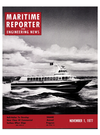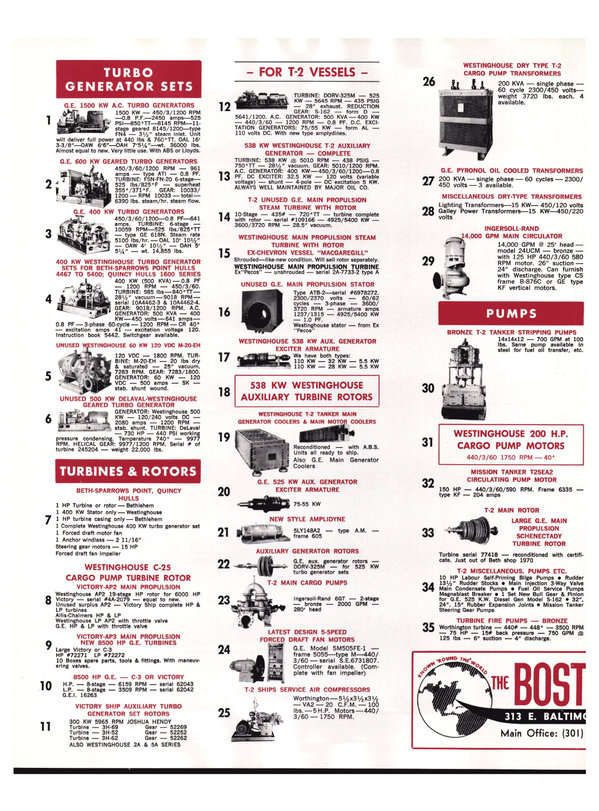
Kawasaki Kobe Works Delivers World's First BORO Liner
The world's first BORO liner, the Bellman, built by Kawasaki Heavy Industries Kobe Works, has been delivered to the Swedish owner, Scandinavian Motorships AB of Stockholm.
The vessel is called a BORO liner because it can transport at the same time both liquid and solid cargoes (BORO standing for bulk, oil, roll-on and roll-off). Development of the ship's design was done jointly by KHI and the Swedish company.
The Bellman is designed to carry trailers, containers, automobiles, roll paper, pulp, lumber, cargo oil and many other cargoes. KHI is now building a second vessel of the same type.
The freighter has its engine room and living quarters at the stern. There are two cargo spaces (car deck and dry cargo deck) under the upper deck, six cargo oil tanks and six water ballast tanks under the dry cargo deck.
As both sides of the multipurpose vessel are designed to have the slopes of an upsidedown trapezoid, the ship has good stability and needs only a small amount of water in its ballast tanks to obtain a navigable draft.
Its width at the draft level is relatively small and as a result, it can navigate more smoothly than other conventional vessels in seas with ice floes.
The cargo space is substantially bigger than that of conventional vessels, and the ship is also designed to obtain a maximum draft by loading freight oil or other cargoes alone.
Cars, containers and trailers can be loaded on the upper deck, cars and roll paper on the cardeck, and cars, containers, trailers, roll paper, pulp, lumber and other cargoes on the dry cargo deck.
Two pneumatic fenders are provided on each side of the upper deck so that the vessel, and its unique trapezoid hull section, will not be damaged by the wharf while berthing.
The fenders are lowered from the upper deck to act as shock absorbers between the ship's hull and the wharf. These fenders can be moved in all directions and are designed to work freely against the ship's rolling and pitching.
Loading and unloading of cargoes other than oil is done on the basis of the roll-on/ roll-off method. Cargoes are loaded from the wharf through a sliding door and rampway at the stern.
A fixed rampway and a 35-ton cargo lift are provided inside the vessel, and they serve for all decks.
In addition to the roll-on/roll-off cargohandling method, lift-on/lift-off operations for containers can also be employed for the upper deck. This variety of cargo-handling methods and facilities enables the vessel to load and unload cargoes in a short time.
The approximate measurements and principal particulars of the vessel are: length overall, 469 feet; molded breadth, 106 feet; molded depth, 26 feet; gross tonnage, 9,471; deadweight tonnage, 10,665; cargo capacity— cargo oil: 14,501 cubic meters; cargo hold: 26,388 cubic meters. The main engine is a Kawasaki M.A.N. K6Z70/120 diesel with a maximum continuous output of 9,300 hp by 145 rpm, producing a maximum trial speed of 17.7 knots.
The Bellman has a complement of 35, and the planned route is Scandinavia — Europe.
Read Kawasaki Kobe Works Delivers World's First BORO Liner in Pdf, Flash or Html5 edition of November 1977 Maritime Reporter
Other stories from November 1977 issue
Content
- New York Harbor Containership Terminals Described In Brochure page: 4
- ARINC Awarded $117,000 MarAd Study Contract page: 4
- NASSCO Awarded $174 Million To Build Destroyer Tender page: 7
- Great Lakes Studies Awards Total $400,000 page: 7
- Second $81-Million Gulf Oil Supertanker Christened At Bethlehem Sparrows Point page: 7
- Bell Aerospace And Halter Marine To Develop New Class Of Commercial Surface Effect Ships page: 8
- Interesting Paper And Past Chairman's Night Opens Season For SNAME New York Section page: 8
- Veliotis To Manage Electric Boat Div. page: 8
- Sun Shipbuilding Consolidates All Marketing Activities —Orth, Winstead And Hunt Named Department Heads page: 10
- Samson Ocean Systems Names John Williamson Regional Manager page: 10
- SNAME 85th Annual Meeting page: 11
- Hartzman To Retire- Bossier Slated For Avondale Presidency page: 11
- American Export Lines $43.1-Million Title XI Approved By MarAd page: 13
- Douglas Oehrlein Joins Dravo SteelShip Corp. page: 13
- McAllister Brothers Names Donald Hankin VP-Engineering page: 14
- Improving Shipbuilding Productivity page: 14
- Ocean Orders Five More Ships page: 14
- British Rail Awards Ferry Contract To Harland And Wolff page: 17
- M a r i n e Boiler Reliability page: 17
- Future Opportunities And Problems Of The Barge Industry page: 18
- Navy Awards Boeing $178 Million To Build Missile Firing Boats page: 19
- Plan To Convert Three Vessels At Estimated Cost Of $12.8 Million page: 20
- Kleschick Elected To Sun Ship Board Of Directors page: 20
- ASRY Drydock Now Open To Service 500,000-DWT Vessels page: 22
- NASSCO Elects Giorgis Group Vice President page: 22
- Norshipco Adopts New Corporate Logo page: 22
- Cayman Energy Ltd. Reports On Activities page: 22
- Samson Sells Marine Survey Division To Local Management page: 22
- Ed Toale Joins Bailey Sales Staff page: 23
- Marine Firms Attend Hoffert Marine Seminar page: 23
- Small Security Vessel Symposium Set For London March 6-10 page: 24
- Bethlehem Steel San Francisco Shipyard Names William Hamilton page: 24
- $3-Million Surface Effect Ship Award To Philadelphia Gear page: 24
- Jonathan Feffer Named President SSI Navigation page: 24
- Navy Adds $4.2 Million To Tracor Contract page: 26
- C.F. Bean Corp. Names Charles R. Barron VP page: 26
- Argo International And Sealol Join Forces page: 27
- Space-Age Insulation Approved By Lloyd's page: 27
- Sperry's First Triple Flow Steering Systems Installed At NASSCO page: 28
- Raytheon Promotes A. Newell Garden page: 28
- National Steel And Shipbuilding Delivers Second Of Four 90,000-Ton Tankers To OSG page: 28
- W.A. Whitney Corp. Introduces New 28XX Tooling Catalog page: 29
- Swan Hunter To Build Vessel To Transport Spent Nuclear Fuels page: 29
- Twenty-Four Women Report For Sea Duty To U.S. Coast Guard page: 32
- GE Credit Buys Third 225,000-DWT Tanker From Seatrain Shipbuilding page: 33
- New York Port Engineers Hears Paper On Surface Preparation Of Steel page: 34
- SCR Propulsion System For Offshore Tug/Supply Vessels page: 34
- Floating Oil Storage Better Prospects For The Unemployed? page: 34
- Alaska Maritime Names William Lorch Valdez Port Manager page: 36
- No. New England Section Of ASNE Reports On Two Technical Sessions page: 36
- An Assessment Of The Market For Tankers Of 300,000-DWT And Over page: 37
- Moran-Thibodeaux Names Captain North Vice President-Sales page: 38
- Diamond Manufacturing Building Ro/Ro Dock For Port Of Tampa page: 38
- Newport News Shipyard Installs Powerful Hoists page: 39
- Kawasaki Endows M.l.T. Research Fund With Gift Of $200,000 page: 39
- Kawasaki Kobe Works Delivers World's First BORO Liner page: 40
- Todd Shipyards Corp. Holds Company Safety Conference In Chicago page: 40
- Study 56—'Sea Trade And Transportation Of Coal' page: 41
- Spanish Society And ABS Enter Agreement page: 42
- J.M. Ringelberg Joins Seaward International page: 42
- U Of California Gives Course On Deepsea Oil Structures Jan. '78 page: 43
- Slatic Named President Ameron Protective Coatings Division page: 43
- Two Management Appointments Announced At Skagit Corporation page: 44
- IMO Pump Bulletin Describes Twin Screw Pumps page: 44
- Drew Chemical Corp. Promotes Walter Smith page: 46
- Kaiser Building Fifteen Mammoth All-Welded Aluminum LNG Tanks For Ships At Avondale page: 46
- New England Company Receives U.S. Funds To Investigate Giant Sphere As Offshore Oil Terminal page: 46
- SNAME And SSC Plan Ship Vibration Symposium For Washington, D.C. October 1978 page: 47
- Electro-Nav To Market New 400-Watt SSB Transmitter/Receiver page: 48
- CIBRO Petroleum Building Super Barge At Todd Shipyards' Houston, Texas Division page: 48
- Stanley Stiansen Elected By ABS page: 49
- OMNITHRUSTER Names J. Michael Melvin VP page: 49
- Santa Fe Reenters Onshore Drilling !n The United States page: 49
- New Henschel Engine Order Telegraph Catalogs Available page: 50
- ASNE Flagship Section Holds First 1977-78 Meeting page: 50
- Wigham Poland Inc. Expands Marine Insurance Division page: 50
- Dredge Technology Corp. Formed In New York page: 53
- Port Of Hueneme Retains John J. McMullen Associates To Prepare Master Plan page: 54
- IMODCO Establishes Houston, Texas Office —M.D. Jackson Named page: 56
- Los Angeles Section's Opening Meeting page: 62
- ALCO Brochure Reports Engine Performance On Residual Fuel page: 64
- American Arabian Partnership Names John S. Hollett page: 64
- Nicholas Liberatore To Head International Activities For Genstar page: 66
- ABS Classes 127 New Vessels In September page: 67
- Belle River Sets Tonnage Record On Great Lakes page: 68
- Congressman Mario Biaggi Will Address First N.Y.C. Diving-Insurance Symposium page: 71
- Miles O'Harra Enters The Consulting Field page: 72
- Clean Venture, Inc. Formed By Spill Contractors To Cover Entire New York Harbor Area page: 73


